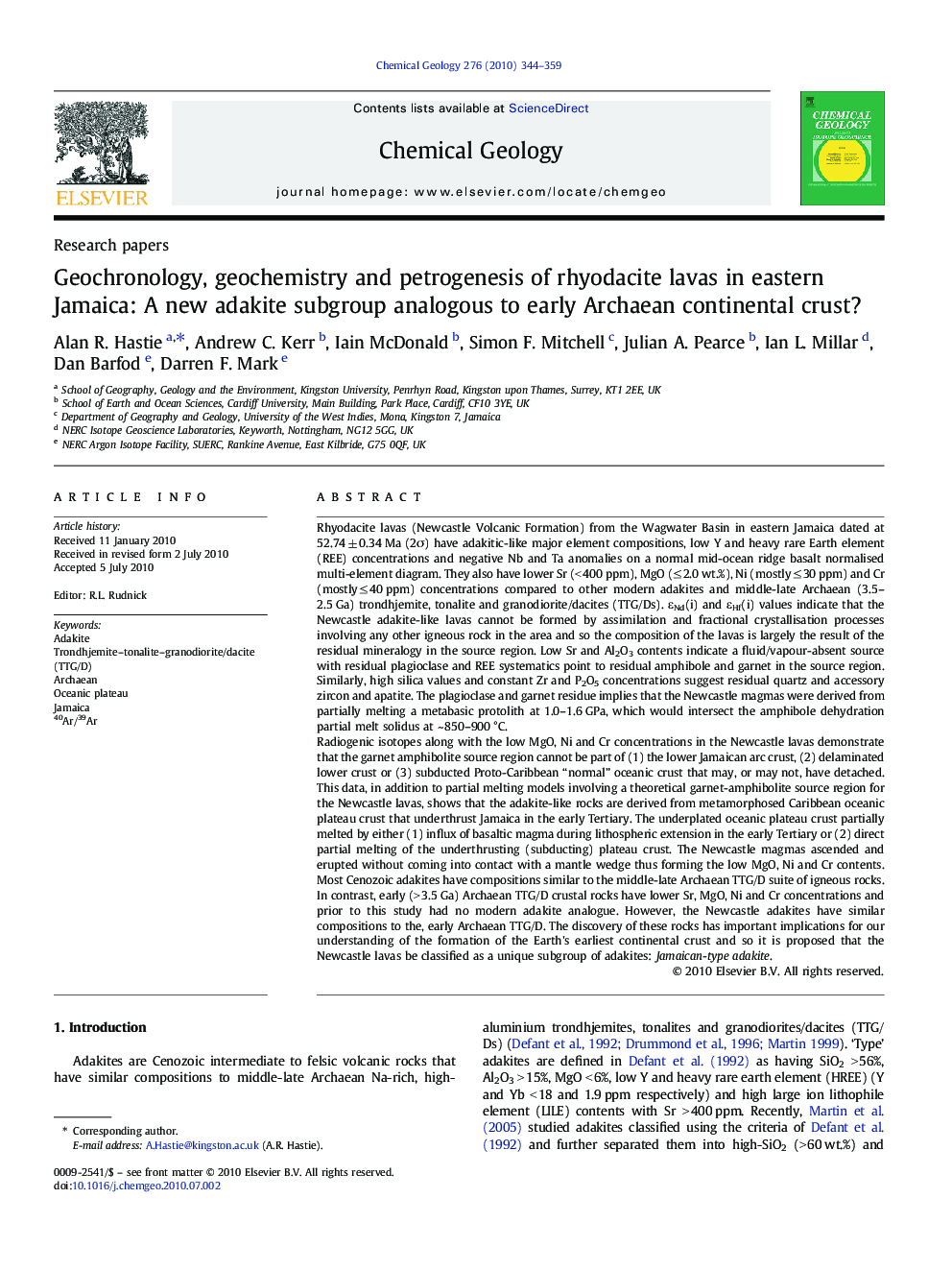| کد مقاله | کد نشریه | سال انتشار | مقاله انگلیسی | نسخه تمام متن |
|---|---|---|---|---|
| 4700028 | 1637683 | 2010 | 16 صفحه PDF | دانلود رایگان |

Rhyodacite lavas (Newcastle Volcanic Formation) from the Wagwater Basin in eastern Jamaica dated at 52.74 ± 0.34 Ma (2σ) have adakitic-like major element compositions, low Y and heavy rare Earth element (REE) concentrations and negative Nb and Ta anomalies on a normal mid-ocean ridge basalt normalised multi-element diagram. They also have lower Sr (< 400 ppm), MgO (≤ 2.0 wt.%), Ni (mostly ≤ 30 ppm) and Cr (mostly ≤ 40 ppm) concentrations compared to other modern adakites and middle-late Archaean (3.5–2.5 Ga) trondhjemite, tonalite and granodiorite/dacites (TTG/Ds). εNd(i) and εHf(i) values indicate that the Newcastle adakite-like lavas cannot be formed by assimilation and fractional crystallisation processes involving any other igneous rock in the area and so the composition of the lavas is largely the result of the residual mineralogy in the source region. Low Sr and Al2O3 contents indicate a fluid/vapour-absent source with residual plagioclase and REE systematics point to residual amphibole and garnet in the source region. Similarly, high silica values and constant Zr and P2O5 concentrations suggest residual quartz and accessory zircon and apatite. The plagioclase and garnet residue implies that the Newcastle magmas were derived from partially melting a metabasic protolith at 1.0–1.6 GPa, which would intersect the amphibole dehydration partial melt solidus at ~ 850–900 °C.Radiogenic isotopes along with the low MgO, Ni and Cr concentrations in the Newcastle lavas demonstrate that the garnet amphibolite source region cannot be part of (1) the lower Jamaican arc crust, (2) delaminated lower crust or (3) subducted Proto-Caribbean “normal” oceanic crust that may, or may not, have detached. This data, in addition to partial melting models involving a theoretical garnet-amphibolite source region for the Newcastle lavas, shows that the adakite-like rocks are derived from metamorphosed Caribbean oceanic plateau crust that underthrust Jamaica in the early Tertiary. The underplated oceanic plateau crust partially melted by either (1) influx of basaltic magma during lithospheric extension in the early Tertiary or (2) direct partial melting of the underthrusting (subducting) plateau crust. The Newcastle magmas ascended and erupted without coming into contact with a mantle wedge thus forming the low MgO, Ni and Cr contents.Most Cenozoic adakites have compositions similar to the middle-late Archaean TTG/D suite of igneous rocks. In contrast, early (> 3.5 Ga) Archaean TTG/D crustal rocks have lower Sr, MgO, Ni and Cr concentrations and prior to this study had no modern adakite analogue. However, the Newcastle adakites have similar compositions to the, early Archaean TTG/D. The discovery of these rocks has important implications for our understanding of the formation of the Earth's earliest continental crust and so it is proposed that the Newcastle lavas be classified as a unique subgroup of adakites: Jamaican-type adakite.
Research Highlights
► Adakite-like lavas on Jamaica that are compositional analogues of the earliest Archaean crust (>3.5 Ga).
► The adakite-like rocks are derived from partially melting metamorphosed oceanic plateau crust.
► The rocks are defined as a new “Jamaican-type” adakite subgroup.
► The existence of these rocks may suggest plate tectonic processes in the early Archaean.
Journal: Chemical Geology - Volume 276, Issues 3–4, September 2010, Pages 344–359